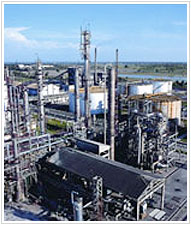|
|
Aluminium
To replace air or nitrogen, creating an inert atmosphere
conducive to manufacturing aluminium; to assist in the
removal of unwanted soluble gases during degasification;
and to remove dissolved hydrogen and particulates from
molten aluminium. |
|
|
Electronics
To provide a protective atmosphere and heat-transfer medium
for growing germanium and silicon crystals for ultra-pure
semiconductors. |
|
|
Glass
Because of its low thermal conductivity, argon provides
window manufacturers with the gas barrier they need to
produce double-pane insulated windows. During the production
process, argon gas is injected between two window panes.
This insulation barrier greatly improves the window's
energy efficiency. |
|
|
Lighting
To fill incandescent and fluorescent light bulbs; to create
blue light in neon lamps. |
|
|
Metal fabrication
To create an inert gas shield during welding; to provide
an oxygen- and nitrogen-free environment for annealing
and rolling metals and alloys; and to flush molten metals
to eliminate porosity in castings. |
|
|
Steel
To displace gas or vapours, and prevent oxidation during
processing; to obtain temperature consistency and homogenous
composition by stirring molten steel; to assist in the
removal of unwanted soluble gases during degasification;
as a carrier gas, to determine the composition of a sample
through gas chromatography; and to flush out carbon monoxide
and reduce chromium losses in the argon-oxygen decarburisation
(AOD) used during stainless steel refining. |


